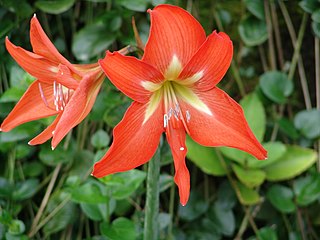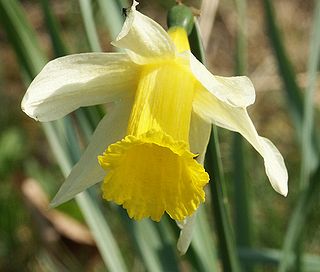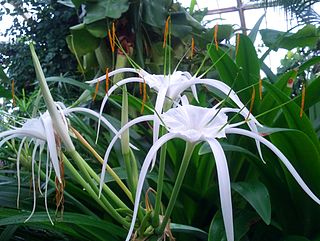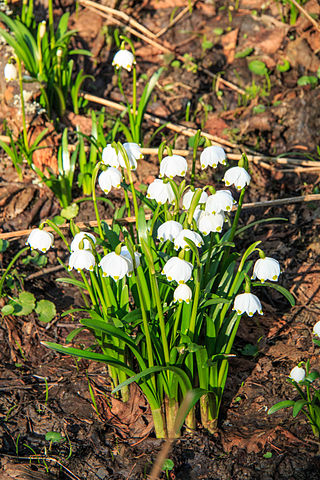
Narcissus is a genus of predominantly spring flowering perennial plants of the amaryllis family, Amaryllidaceae. Various common names including daffodil, narcissus, and jonquil, are used to describe all or some members of the genus. Narcissus has conspicuous flowers with six petal-like tepals surmounted by a cup- or trumpet-shaped corona. The flowers are generally white and yellow, with either uniform or contrasting coloured tepals and corona.

Hippeastrum is a genus of about 90 species, and over 600 hybrids and cultivars, of perennial, herbaceous and bulbous plants, native to tropical and subtropical regions of the Americas, from Mexico south to Argentina and on some islands in the Caribbean. The majority have large, fleshy bulbs—usually about the size of a softball—and tall, broad, strap-like leaves that are (generally) evergreen, and large red or purple flowers. Numerous colors and cultivars have been created over the past hundred years.

Streptosolen is a monotypic genus of flowering plants in the family Solanaceae. It is closely related to the genus Browallia, within which it was originally placed. The single species, Streptosolen jamesonii, the marmalade bush or fire bush, is an evergreen shrub bearing loose clusters of flowers which change gradually from yellow to red as they develop, resulting in an overall appearance resembling orange marmalade, found in open woodlands in Colombia, Venezuela, Ecuador, and Peru. The plant has become naturalized in certain localities in Hawaii.

Hyacinthus orientalis, the common hyacinth, garden hyacinth or Dutch hyacinth, is a species of flowering plant in the family Asparagaceae, subfamily Scilloideae, native to southwestern Asia, southern and central Turkey, northwestern Syria, Lebanon and northern Palestine. It was introduced to Europe in the 16th century. It is widely cultivated everywhere in the temperate world for its strongly fragrant flowers which appear exceptionally early in the season, and frequently forced to flower at Christmas time.
Amancay or Amankay is a common name of Quechua origin.

Narcissus pseudonarcissus, commonly named the wild daffodil or Lent lily, is a perennial flowering plant.

Hymenocallis (US) or (UK) is a genus of flowering plants in the amaryllis family native to the Americas.

Zephyranthes carinata, commonly known as the rosepink zephyr lily or pink rain lily, is a perennial flowering plant native to Mexico, Colombia and Central America. It is also widely cultivated as an ornamental and naturalized in the West Indies, Peru, Argentina, Brazil, the southeastern United States from Texas to Florida, Zimbabwe, South Africa, China, Korea, the Ryukyu Islands, Assam, Nepal, Bhutan, Sri Lanka, Solomon Islands, Queensland, Society Islands, Kiribati, and Caroline Islands.

Zephyranthes robusta, commonly known as the Brazilian copperlily, pink fairy lily or the pink rain lily, is a species of herbaceous flowering bulb in the family Amaryllidaceae. It is native to Brazil, Argentina and Uruguay, but is now naturalized in Florida, Colombia, South Africa, and Mauritius.

Ismene, or Peruvian daffodil, is a genus of South American plants in the Amaryllis family. The species are native to Peru and Ecuador and widely cultivated elsewhere as ornamentals because of their large, showy flowers.
Eucrosia mirabilis is a species of plant from Ecuador. In the original scientific description in 1869, it was believed to be from Peru, but there is little evidence it ever grew there. The plant disappeared from cultivation until it was found in Ecuador in 1997. Its natural habitats are seasonally dry lowland areas to elevations of 1500 m.

Zephyranthes rosea, commonly known as the Cuban zephyrlily, rosy rain lily, rose fairy lily, rose zephyr lily or the pink rain lily, is a species of rain lily native to Peru and Colombia. They are widely cultivated as ornamentals and have become naturalized in tropical regions worldwide. Like all rain lilies, they are known for blooming only after heavy rains.

Stenomesson is a genus of bulbous plants in the family Amaryllidaceae. All the species are native to western South America.

Hippeastrum calyptratum is a flowering perennial herbaceous bulbous plant, in the family Amaryllidaceae, native to Brazil.
Allium tenuiflorum is a Mediterranean species of wild onion found in Algeria, Morocco, Libya, Italy including Sardinia, and the Balkans.

Leucojum vernum, commonly called the spring snowflake, St. Agnes' flower, and rarely snowbell among others, is a species of flowering plant in the family Amaryllidaceae. It is native to central and southern Europe from Belgium to Ukraine. It is considered naturalized in north-western Europe, including Great Britain and parts of Scandinavia, and in the US states of Georgia and Florida. This spring flowering bulbous herbaceous perennial is cultivated as an ornamental for a sunny position. The plant multiplies in favourable conditions to form clumps. Each plant bears a single white flower with greenish marks near the tip of the tepal, on a stem about 10–20 cm (3.9–7.9 in) tall, occasionally more.

Crinum flaccidum, known variously as the Darling lily, Murray lily or Macquarie lily, is a species of flowering plant in the family Amaryllidaceae. It is native to inland Australia. The Darling river people — the Paakantyi — called this plant paalampaltharu.

Galanthus plicatus, the pleated snowdrop, is a species of flowering plant in the family Amaryllidaceae, native to eastern Europe and western Asia. It is a spring flowering bulbous herbaceous perennial.

Stenomesson leucanthum is a species of flowering plant in the family Amaryllidaceae. It is native to Peru. Pierfelice Ravenna, the Chilean botanists who first formally described the species, using the basionym Pucara leucantha, named it after its white flowers.

Pamianthe peruviana, also known as the giant Peruvian daffodil, is a species of epiphytic plant native to seasonally dry areas of Peru and Bolivia.



















